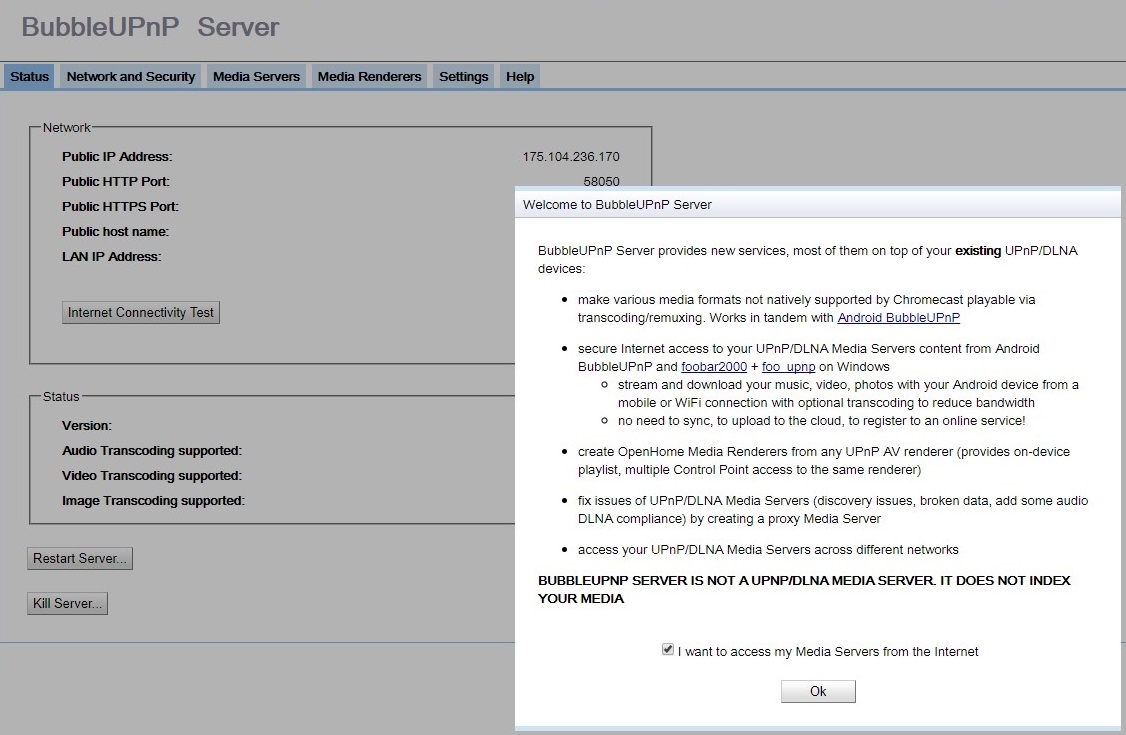

- MINIMSERVER BUBBLEUPNP SERVER HOW TO
- MINIMSERVER BUBBLEUPNP SERVER INSTALL
- MINIMSERVER BUBBLEUPNP SERVER FULL
- MINIMSERVER BUBBLEUPNP SERVER SOFTWARE
- MINIMSERVER BUBBLEUPNP SERVER MAC
This will still work – the difference is that your tablet is controlling track-by-track playback instead of BubbleUPnP Server. You may be wondering what happens if you select the regular (UPnP) version of the renderer from the menu instead of the OpenHome version. Tap on the three dots to bring up the menu to play an album or add it to your TIDAL favorites. You will get the TIDAL main menu:įrom there, you can access your TIDAL favorites (albums, playlists, artists), browse by genre, or use search: Check the Enable box and tap on Account to enter your TIDAL username and password, then tap OK.īack on the main screen, go to the Library view, scroll down and tap on TIDAL. Open Settings (at the bottom of the menu), scroll down and select Local Media Server, then scroll down again and select TIDAL. For the library, select Local Media Server. For the renderer, select “volumio (OpenHome)” (or the equivalent name for your own). Once the BubbleUPnP app is installed, drop down the main menu (top left).
MINIMSERVER BUBBLEUPNP SERVER FULL
The full licensed version of the BubbleUPnP app costs a few dollars, and you pay for it by purchasing the BubbleUPnP licensing app.) (It’s appropriate that BubbleUPnP is the first controller listed in this article, as BubbleSoft have provided us with BubbleUPnP Server for free.
MINIMSERVER BUBBLEUPNP SERVER INSTALL
To control playback from an Android tablet, install the BubbleUPnP app. Choose any of the following three sections, depending on the platform(s) that you want to use. The next task is to install and/or configure a controller of your choice. In this example, I have used “volumio-tidal.” Finally, turn on the option “Gapless playback.” (It does work with Volumio.)Īnd that’s it. On the Media Renderers tab, select your streamer and turn on the option “Create an OpenHome renderer.” In the “Room” field, type in a different name. On the Media Servers tab, I select each server in turn and turn off “Make this Media Server available … for Internet access”: (If you lose it, it is at On the Network&Security tab, I turn all of the options shown below off: Bookmark it to make it easy to find later. When the installer completes, it will open a webpage interface to BubbleUPnP Server. Note: if you install BubbleUPnPServer on a Windows machine, it’s not possible to run a controller like Linn Kazoo on the same machine. You also have access to a broader range of controllers (see following sections).ĭownload and install BubbleUPnP Server as described here: Essentially, BubbleUPnP Server manages the playlist on behalf of Volumio, so you can have multiple tablets connected and they will all see the same playlist, for example. This program acts as a “proxy” for a UPnP renderer (like Volumio), effectively turning it into an OpenHome renderer. The first thing needed is a program called BubbleUPnP Server running on one computer on your network. I have not tried the Qobuz option, but I expect it will work fine also. In the following, Qobuz (another lossless streaming service) often appears alongside TIDAL. Now that we are using BubbleUPnP Server, a broader range of controllers becomes available to us, and I have selected three that I like on three different platforms: BubbleUPnP on Android, LUMIN App on iPad, and Linn Kazoo on Mac.
MINIMSERVER BUBBLEUPNP SERVER MAC
You can install it on your Mac (or a Windows or Linux computer).
MINIMSERVER BUBBLEUPNP SERVER HOW TO
The article starts by explaining how to install and configure a server application called BubbleUPnP Server. You will also need a UPnP renderer to send audio to, and in this article I will assume it’s a Raspberry Pi running Volumio. The article assumes that you have a Mac computer, but the Windows or Linux user should be able to adapt easily enough. I decided to write down this short step-by-step guide for those who are as mystified as I was. Having just set up the Raspberry Pi to play music, we want to be able to send our streamed lossless audio there too… Still, we’re audiophiles, and the hot topic right now is lossless streaming – that is, CD quality audio streamed from the Internet, with TIDAL getting most of the press.
MINIMSERVER BUBBLEUPNP SERVER SOFTWARE
For the sake of having a concrete example, the software distribution Volumio was installed on the Raspberry Pi.īut what about music streamed from the Internet? If you’ve poked around the Volumio interface, you’ve probably noticed that it has Internet radio stations. Part 1 focused on putting the streamer together and initial setup, and Part 2 showed how to configure a music server to read your iTunes (or other) files and send them to the streamer. In earlier articles on networking your Mac music system, I showed how to set up an inexpensive networked music streamer using a Raspberry Pi and a HifiBerry DIGI+ digital output card.


 0 kommentar(er)
0 kommentar(er)
